Crunch, Reach, Pass
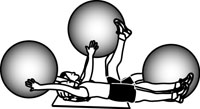 |
- Begin by laying with your back on the floor and facing the ceiling (supine position). Hold the stability ball with your arms outstretched above your head (the ball will be resting on the floor). (see figure 1).
- In a controlled motion, use your abs to perform a sit-up, keeping your arms straight. Simultaneously, as your are perform the sit up, raise your legs. You should "fold" at your abdominal muscles, and your arms and legs should come together at the top of the movement.
- Pass the ball from your hands to your feet, and return to the starting (supine) position. The stability ball should be held between your feet.
- Repeat the movement, passing the ball from your legs to your hands and vice versa with each repetition.
Stationary Lunge
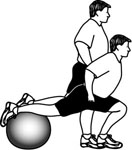 |
- Start with a large stability ball behind you. Carefully place a leg on the ball. Your shin should be in contact with the top of the ball. Place your front leg as far out in front of you back leg as you can while maintaining your balance and comfort. Your front foot should be planted firmly on the floor (see figure 2).
- To perform this stability ball exercise, lower yourself by slowly bending your front leg until the top of your leg is parallel to the floor. Be sure to keep your back leg firmly on top of the stability ball throughout the movement.
- Finish the repetition by returning to the starting position.
- Repeat the movement, performing the required number of reps. Repeat with the opposite leg on the ball.
- Note: In step 2, if you are just beginning, lower yourself as far as you are comfortable until your balance and range of motion have increased.
- Note: To minimize the chance of injury, try not to allow your knee to drift past your toes as you lower yourself.
Pike
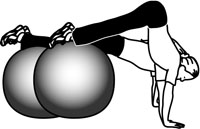 |
- Begin in a push-up position with your shins on top of the exercise ball (see figure 3).
- Keeping your legs as stiff as possible, use your abs to roll the ball forward, lifting your hips toward the ceiling.
- Hold this position for a three count while flexing your abdominal muscles.
- Slowly return to the beginning position.
Wall Squat
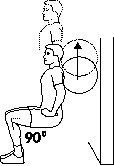 |
In order to correctly perform this exercise, you need to find a wall that is completely flat and with not impediments such as pictures or windows.
- Begin by placing your stability ball against a wall, and, while standing upright, lean against the ball with your back. Your feet should be slightly out in front of you and approximately shoulder width apart (see figure 4).
- Using a controlled motion, lower your self until the top of your thighs are parallel to the floor.
- Slowly return to the standing upright position by pressing your feet into the floor and pushing your body back to upright.
- Note: If you just beginning a workout routine, In step 2, lower yourself as far as you are comfortable until your range of motion has increased enough to lower your body until your thighs are parallel to the floor.
- Note: Keep your head up and your eyes facing forward though out the entire movement.
- Advanced Tip: For an added challenge, you can hold dumbbells in each hand. Using extra weight will help you build muscle and burn fat faster during this stability ball exercise.
- Advanced Tip: The narrower your stance, the more you involve your quads, while the wider your stance, the more your glutes are used to lift the weight. For balanced muscle development and toning, use the neutral stance described in step 1 above.
Push Up with Hands on the Floor
 |
- Start by positioning yourself in the standard push-up position, with your hands slightly wider than shoulder width. Place your feet on top of your exercise ball.
- Slowly lower yourself to the ground until your chest nearly contacts the floor.
- Perform a push-up by pressing yourself from the floor back to the position number 1 (the starting position).
Note: If you are a beginner , place the ball under your thighs in step 1. The closer the ball is placed to your feet, the harder it is to complete the exercise.
Incline Dumbbell Press
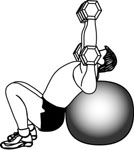 |
- Begin by squatting down and lying back so that your upper back is in contact with the exercise ball (see figure 6). Hold the dumbbells at the top your chest.
- Press the dumbbells toward the ceiling, finishing with your arms extended. At the top of the move, the dumbbells should come together over your chest.
- Return to the starting in a controlled movement and repeat for the prescribed number of repetitions.
- Note: During the press, be sure to concentrate on keeping your wrists and your elbows aligned to avoid losing control of the weight. You should use the assistance of a spotter for this and other stability ball exercises that use weights.
- Tip: At the top of the movement, squeeze your pectoral muscles hard for a count for extra muscle stimulation.
Stability Ball Crunch
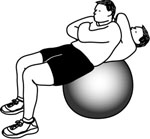 |
- Start by sitting on the exercise ball as if you were sitting on a chair. Slowly lean back and walk your feet forward until the ball is positioned on your lower back region and you are looking toward the ceiling. The top your legs should be parallel to the floor (see figure 7).
- Cross your hands on your chest and keep your head in a neutral position looking forward (toward the ceiling). Your chin should not touch your chest at any point during this exercise.
- Raise your torso by contracting your abdominals to perform the crunch.
- Hold for a count, squeeze your abdominals, and return to starting position.
- Note: You can add further resistance by holding weights in your arms as you perform this exercise.
Back Extension
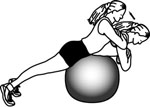 |
- Begin by kneeling on the floor in front of stability ball and lie face down so that the ball is at your upper abdominal region. Your head should be facing the floor.
- Cross your hands over your chest, and raise your torso approximately six inches.
- Hold for a count, then slowly and under control, lower your torso to the starting position.
- Note: The further the ball is placed toward your hips, the harder the exercise is to perform.
- Note: You can add further resistance by holding weights in your arms as you perform this exercise.
Shoulder Press
 |
- To start this stability ball exercise, sit on the ball in an upright position as if you were sitting on a chair. Hold two dumbbells next to your ears with your palms facing forward (away from you)
- Press the weights toward the ceiling, keeping your hands and elbows aligned throughout the movement. The weights should come together above your head as your arms are extended upward.
- Return to the dumbbells to the start position in a slow and under control movement.
Dumbbell Bent Over Row
 |
This exercise requires a larger stability ball that approximately waist height.
- Stand facing the ball with your legs approximately shoulders width apart. Bend forward at the hips, keeping your back straight and place one hand on the ball in front of you. Hold a dumbbell in the opposite hand with your palm facing your body, and allow your arm to hand freely. Bend your knees as much as necessary for comfort, but keep your back roughly parallel to the floor.
- Pull, or "row," the dumbbell up toward your upper body. Be sure to keep you elbow tight to you body, and squeezing your shoulder blades together at the top of the lift in order to fully contract and emphasize your lats.
- Slowly lower your arm and lower the weight back to the starting position with your arm hanging straight down.
- Perform the recommended number of repetitions and repeat with the opposite arm.
Abdominal Tuck
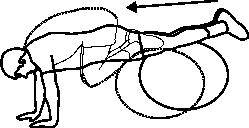 |
This stability ball exercise is a less advanced version of the pike.
- Start with your shins on the stability ball with your hands on the floor in a push-up position (figure 11). The closer the ball is located toward your feet, the more difficult this exercise will become.
- Pull the fitness ball toward your chest by bending your knees and lifting your hips until you are in the tucked position with your knees at your chest.
- Carefully return the exercise ball to the starting position by extending your legs until you are again in the push up pose.
- I often like to do a push up, then an ab tuck, and then a push up… especially when I am looking for some variation to my routine.
Oblique Stability Ball Crunch
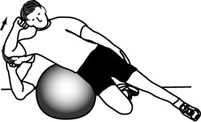 |
- Begin by kneeling down on one knee beside the exercise ball with the knee that is on the floor next to the fitness ball (see figure 12).
- Carefully lie sideways over the stability ball. You bottom arm (arm closest to the ball) should be bent with your hand behind your head and your top arm (arm farthest from the ball) can either be in the same position (hand behind head) or lying on your side (see figure 12). Having your top hand behind your head makes the exercise more difficult.
- Slowly raise you body upward by lifting your shoulder, pushing your hips into the ball and pulling with your obliques, making sure not to twist your body.
- Squeeze your obliques for a count and then slowly lower yourself back to the starting position.
exercises for an exercise ball is an awesome exercise skill i like it dude
ReplyDelete